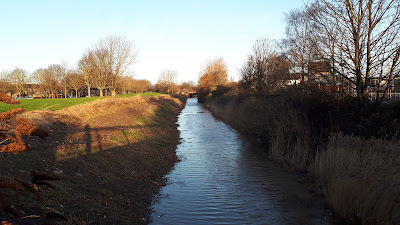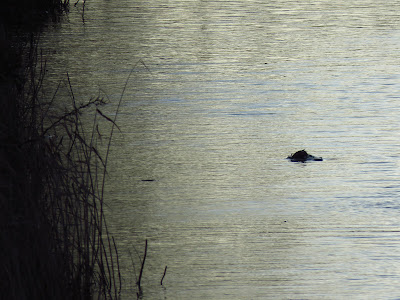
Where Green Lane meets Wilcolmlee is the end of the drain, where it meets the river Hull. I walk there, although there is little to see. The last section of the drain is not publicly accessible. As far as I can see there are no waterbirds on it.
I walk around the block to get to the bridge at Barmston Road. Here there is a lovely view to the north. A few Moorhens and Mallards are about. The banks are grassy and public access, I walk along to Fountain Road, then I take Bridlington Avenue to walk around another section which is not accessible.
I know this area well, as it is within the Sculcoates patch. One Little Grebe is visible, although it is hiding on the reedbeds opposite the path. The Little Grebes are very shy and hard to count. You need to scan the water surface from a distance and for a while, as if they are feeding they spend more time underwater than over. As they emerge, they look around and dive again.
Now I need to take a long detour to get to the next stretch of footpath, by Clough Road. I walk to Beverley road, then take Ryde street to avoid the traffic. The short walkable bank off Clough road is quite interesting. There are two Little Grebes, a Coot, 4 mallards and 18 moorhens on it. The drain is flowing, pushed by the wind, and the floating duckweed and Azolla move downstream.
Another detour, this time along the cycle track by Croda, then to Beresford Avenue to walk along another stretch. Before I do, I peek over the bridge wall and spot another two Little Grebes, which, as expected, I don't see from the bank.
I take Wellesley Avenue to Beverley Road, where a stretch of drain can be watched from the bridge, and afterwards I cross the road and walk to Marydene drive, where I'm hoping to see the drain, but the access is blocked as the land is private and fenced off, so I retrace my steps to Beverley Road. A Siskin and a flock of eight Jackdaws is what I get from this short detour. I walk along Beverley Road to take the next stretch of drain at Endyke Lane. From this point, the one of the banks of the drain has got a public access footpath. A pair of Mistle Thrushes are on the playing fields of Endyke Academy.
After crossing Greenwood Avenue, I enter one of my favourite stretches of the drain: leafy and with a double bend, and the banks have a path at a lower level. There is usually a pair Mute Swans here, but maybe they are away for the winter. A Great Tit calls alarmed. As I walk up the path a Red Kite flies quite low over my head, its fantastic colours gleaming in the sun. Unfortunately, I have the camera in the wrong setting and by the time I'm ready it's disappearing in the distance, still, a nice addition to this years Hull list.
On the final stretch, by Thorpepark Road, the most notable thing is a group of 4 Greylags, on an area where I had a mating pair in my last visit last spring. I pass the Counter Dyke. After reaching the A1079, it's time to turn round.
This is the final waterbird count:
Moorhen: 70Mallard:72
Little Grebe 7
Coot: 1
Greylag: 4
Cormorant: 1



















No comments:
Post a Comment